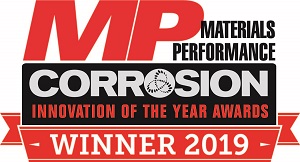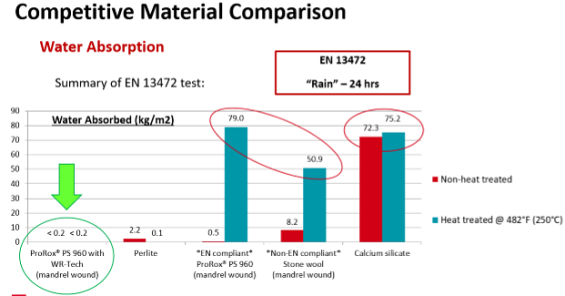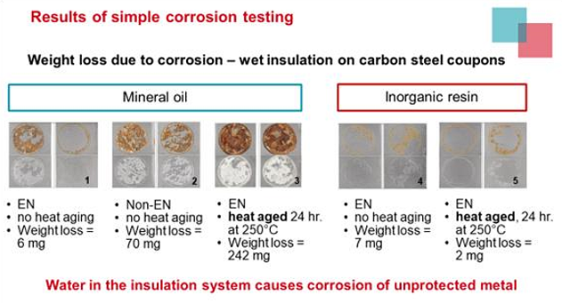A newly designed mineral wool pipe insulation product from ROCKWOOL Technical Insulation (Milton, Ontario, Canada) offers a new route to dealing with corrosion under insulation (CUI) by successfully maintaining hydrophobicity throughout a wide range of CUI temperatures.
According to the company, CUI accounts for an estimated 10% of overall maintenance costs and 40 to 60% of pipeline maintenance costs in the oil and gas industry, and it especially plagues aging industrial facilities as they require more maintenance.
Mineral wool insulation is a frequently specified material for high-temperature applications in these facilities, such as refineries and petrochemical plants, but mineral wool’s water repellency has long been a concern—especially at higher temperatures. By utilizing a water repellent binder known as WR-Tech,† however, the company says its ProRox†
mandrel wound pipe sections can better reduce corrosion and extend the service life of piping. Other benefits include lower maintenance costs and a decreased risk of pipe leaks and failures, the developer explains.
 The product—which was one of 10 winners in the Materials Performance 2019 Corrosion Innovation of the Year Awards program—can work in tandem with existing corrosion prevention techniques such as coatings, inspections, monitoring systems, and more. Full mechanical details and case histories are available at the awards web site.
The product—which was one of 10 winners in the Materials Performance 2019 Corrosion Innovation of the Year Awards program—can work in tandem with existing corrosion prevention techniques such as coatings, inspections, monitoring systems, and more. Full mechanical details and case histories are available at the awards web site.
Historical Limitations of Mineral Wool
According to the developer, three main types of additives are used to obtain water repellency in mineral wool: mineral oil-based additives, silicone oil-based additives, and inorganic resin additives.
“Most mineral wool used globally is installed inside of dry buildings, where water repellency is needed only to ensure that the insulation is dry at the time of installation,” explains Osama Hamza, project management officer and winner of the recent award.
“However, the mineral oil additive is vulnerable to oxidation at high temperatures,” Hamza adds. “High temperature gradients may also cause migration, where the oil moves around. Longer-term warm water exposure can wash out the oil. Loss of water repellency is typically seen at temperatures above 150 °C [302 °F].”
Based on temperature limits, silicone oil-based additives were introduced about 20 years ago to increase the temperature resistance of the water repellency properties to more than 250 °C [482 °F], Hamza says. However, he notes that these silicone oils can cause surface defects in coatings, such as voids. Thus, in many industries, the use of insulation with silicone oils is restricted.
Most recently, inorganic resin additives have become a popular choice to improve the water repellency of mineral wool. “They provide the benefits of silicone oil with heat stability, but are not mobile and do not affect coating operations,” Hamza explains.
The company says its innovation is the first open-cell insulation in the industry to successfully utilize an inorganic resin additive for water repellency. “Our sections are changing the technical landscape and industry perception of open-cell insulation materials and water absorption,” Hamza says. “The current perception is that open-cell materials absorb water and are at a higher risk of CUI. These sections have bridged the CUI gap, not only for mineral wool materials, but for open-cell insulation materials.”
Technical Features of New Additive
According to the company, the water repellency of mineral wool is obtained via a combination of the binder used in the mineral wool and water repellency additives. The efficiency and durability of the repellency depends on the distribution, type, and amount of the additive.
The additives work by changing the surface tension of the mineral wool fibers, which makes it more difficult for the fibers to get wet. In turn, this delays the penetration of water into the mineral wool.
The company’s new system utilizes a proprietary additive based on an inorganic resin that is introduced into the mineral wool early in the production process. The timing of the additive placement allows it to coat each individual fiber of the insulation material, resulting in a more uniform distribution. This homogenous distribution allows for maximum water repellency performance after the product is cut and installed.
According to Hamza, the additive is stable at higher temperatures and allows mineral wool to effectively retain hydrophobicity within the critical CUI temperature range of 50 °C (122 °F) to 175 °C (347 °F) and is durable up to 250 °C (482 °F). “By improving the water repellency, less water is expected to be in contact with the base piping for shorter durations, ultimately allowing for decreased corrosion damage,” he explains.

Third-Party Test Findings
To demonstrate the technology, the system was tested for water absorption according to DIN EN 134721 by a third-party testing laboratory (Figure 1). The EN 13472 test simulates the water absorption caused by exposure to rain during product installation.
The study compared results of water absorption across different types of insulation before and after heat treatment up to 250 °C. Even after heat aging at 250 °C for 24 hours, the water absorbed by the system utilizing the new water repellency additive was only < 0.2 kg/m2, as compared to 79 kg/m2 in mineral wool samples with a mineral oil additive.
To demonstrate the effects of the new inorganic resin additive on water absorption properties and corrosion rate, a simple test method was constructed. The method consisted of a water exposure phase aimed at saturating the mineral wool samples, followed by an exposure period—where the wet insulation was positioned on carbon steel test coupons. Insulation samples were partially immersed in demineralized water for seven days; the coupons were placed on a hot plate at ~50 °C (122 °F); and corrosion was measured as weight loss.
The insulation with the inorganic resin gave the lowest amount of corrosion, both for heated and heat-aged samples (Figure 2).

Since mineral wool is already used by the industrial market, incorporating the technology should make the adoption and use of the product seamless, Hamza explains. He notes that there are no changes to product handling, storage, or installation. However, the key for the developer could be modifying industry perceptions regarding open-cell insulation materials and water absorption.
“The challenges are in education and awareness, and monitoring and measuring real-world data,” Hamza says. “These challenges can be overcome with widespread dissemination of information, publication of technical findings, and engaging owners and customers for feedback that will allow us to monitor and measure results to provide further proof of success.”
The stone wool mandrel-wound pipe sections with the inorganic resin additives have been commercially available since the 2017 fourth quarter.
Source: ROCKWOOL Technical Insulation, rti.rockwool.com. Contact Osama Hamza—e-mail: osama.hamza@rockwool.com.
† Trade name.
Reference
1 DIN EN 13472 (latest revision), “Thermal Insulating Products for Building Equipment and Industrial Installations—Determination of Short-Term Water Absorption by Partial Immersion of Preformed Pipe Insulation” (Berlin, Germany: DIN).